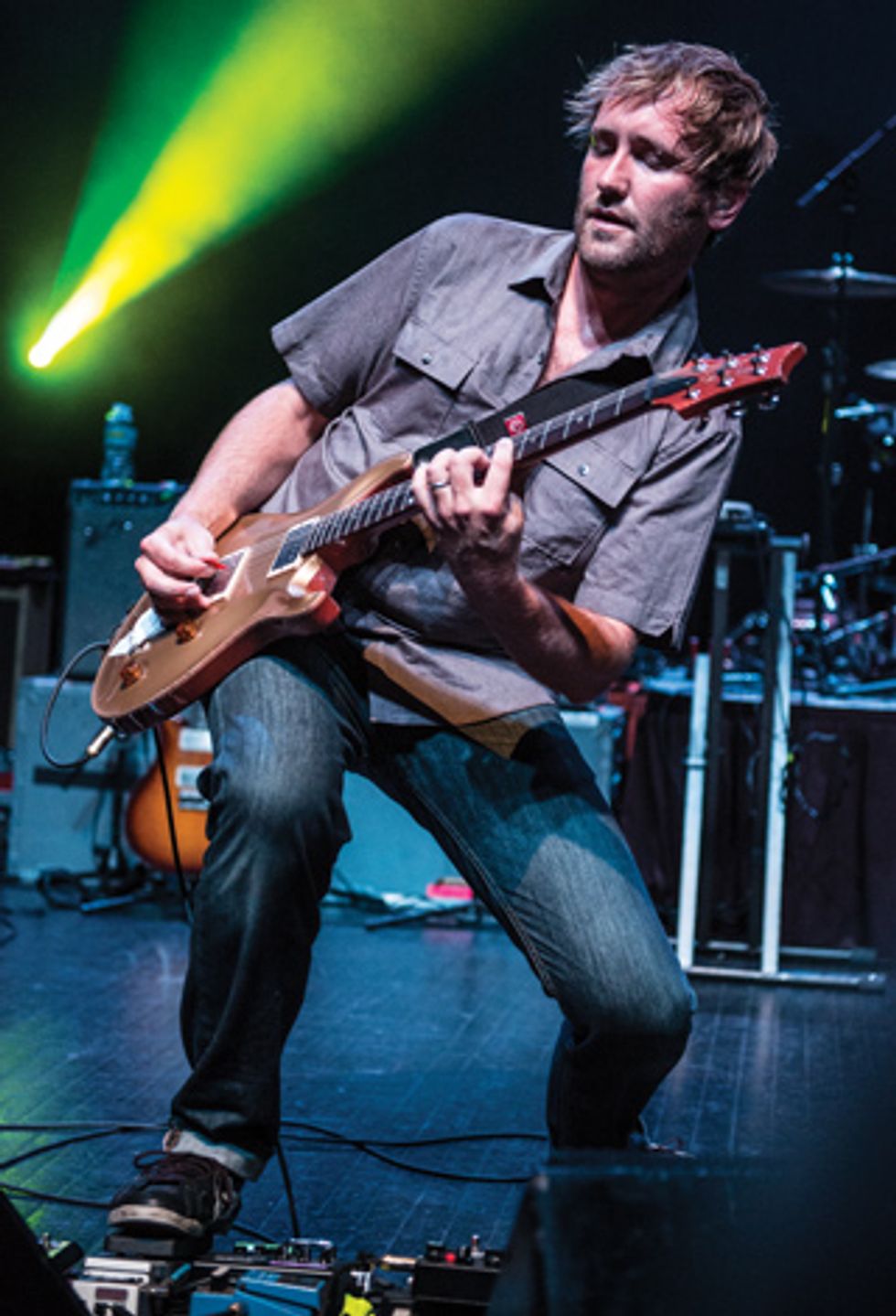
Photo by Elise Shively
When you first listen to Minus the Bear, it registers in your cranium as radio-friendly, indie-tinged pop. But listen closer, and you’ll hear intricately woven, kaleidoscopic parts hidden within—disparate elements like live sampling, contrapuntal melodic guitar parts, math-metal-inspired polymetric riffs, and sometimes just balls-to-wall shred. For evidence, one must look no further than MTB’s fifth LP, Infinity Overhead.
“You’re peeling layers upon layers and hearing something you didn’t hear the first time,” says Dave Knudson, guitarist for the Seattle-based quintet “which is how great music should be.”
Because of those shifting, seemingly inconsistent parts, the group’s music can be difficult to classify. Their perpetually changing sound can be directly tied in to Knudson’s everexpanding musical headspace. Like many guitarists who grew up in the ’80s, Knudson was initially drawn to guitar after hearing Metallica. “I picked up guitar after hearing … And Justice for All. I was, like, ‘Holy shit—what the hell is this? I gotta play guitar!’” He later moved on to progressive bands like Yes and King Crimson, then punk and hardcore, and then to IDM (intelligent dance music, aka “braindance”), which inspired the Line 6 DL4 Delay Modeler-driven looping madness that has become a central part of his guitar approach.
“A few years ago, I started listening to a lot of electronic music like Four Tet and Caribou—sampling and glitchy stuff. I thought, ‘Wow, that’s a cool sound. I wonder if I can reproduce that on guitar,’ and that’s where a lot of the sampling stuff came from. I discovered I could do that if I just sampled it into the DL4 and made it double-time.”
For MTB’s 2010 release, Omni, the band looked past their inner circle and called on Grammy-winning producer Joe Chiccarelli, who introduced a stronger emphasis on keyboard and synth textures, but this year’s Infinity Overhead finds the band revisiting their formative, guitar-centric sound.
Minus the Bear’s sound seems
to evolve from album to
album. Which side of your
musical personality came out
on Infinity Overhead?
When we first formed in 2001,
we had come from a more
punk-rock/hardcore community,
but I think we all wanted
to break out of the more rigid
genre rules and experiment with
cool, complex technical music
but in a pop format. The first
couple of records have a lot of
dance-y stuff on them, like Daft
Punk-inspired indie-rock stuff.
Then we got more into prog
rock—Planet of Ice was sort of
a journey through late-’60s,
early-’70s prog rock. Now I
think we’re coming back and
joining both of those loves with
this new record.
What is your favorite track on
the album?
I think the consensus is that
“Diamond Lightning” is the
favorite for all of us. Everybody
loved how that song was written
and the fact that we wrote it as
one piece of music with “Toska”
together. It was written that way
and is always played in rehearsals
as one song.
That’s surprising, because
“Toska” has such a different
vibe—it’s more upbeat and
has more aggressive guitar,
like that repeating, keyboardesque
figure midway through
the song. Is that part tapped?
No, it’s just picked—a lot of
hammer-ons, pull-offs, and picking.
There are a couple of songs
that have two-hand tapping, like
the main riff in “Lonely Gun.”
That crazy, almost synthed-outsounding
part is a two-handed
tapping riff.
“Lonely Gun” also has some
crazy-fast alternate picking.
Yeah, in the bridge there’s a
pretty fast picking part—there’s a
time and a place for everything.
Like, on this record there’s a time
for a song like “Cold Company”
to be totally extreme and kind
of flashy, and there’s a time to
be a little more restrained like
on “Diamond Lightning” or
“Listing,” where it’s just more
of a traditional acoustic thing.
There are some songs that don’t
need a brutal, insane tapping
solo. The tapping stuff was what
a lot of people loved about the
first couple of records. I love
doing the two-handed tapping
stuff, but using it more for a
rhythmic riff rather than for a
flashy solo. But I think there are
times for both extremes.
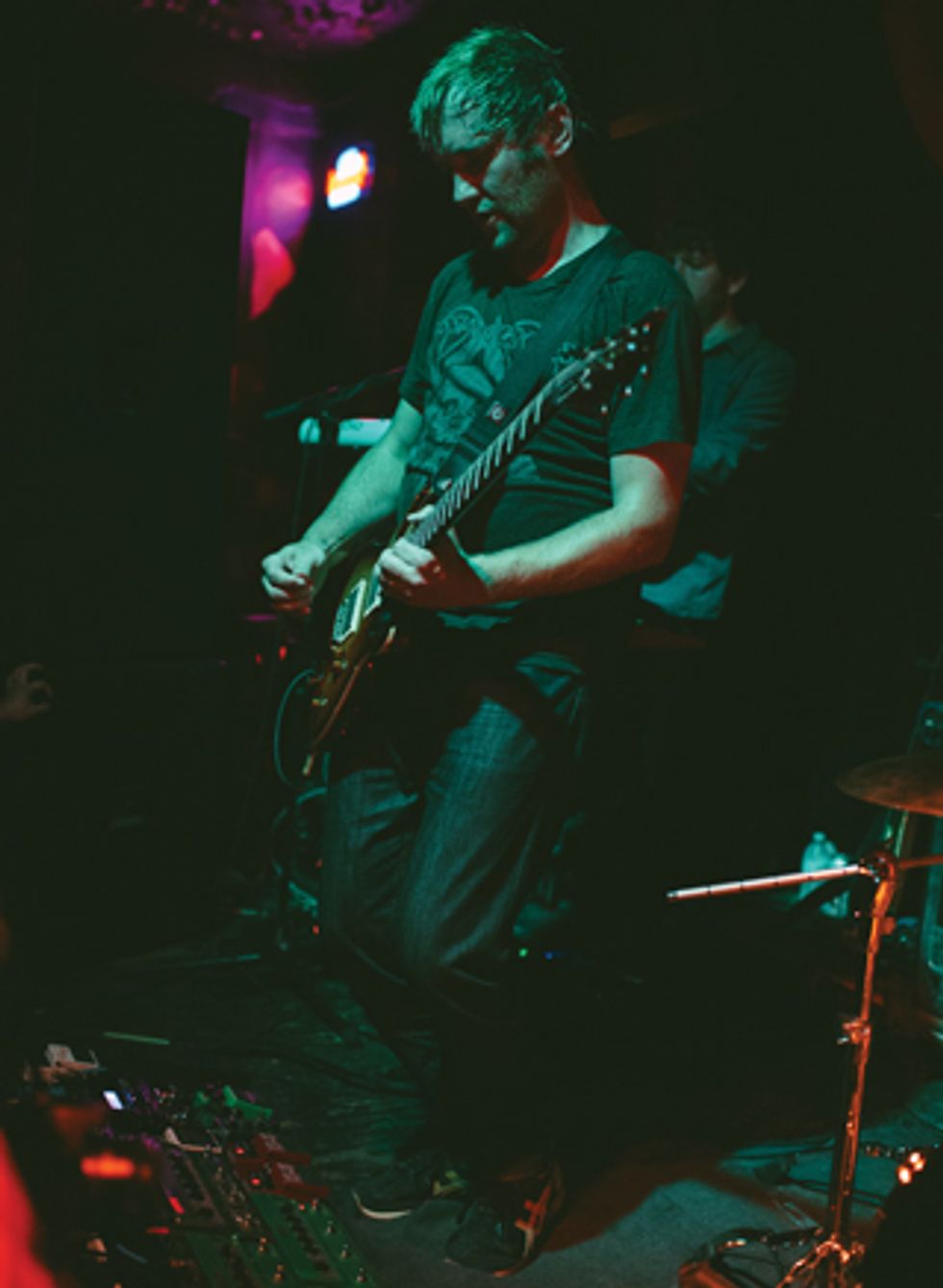
MTB gets intimate at Seattle’s Cornet Tavern. Photo by Amber Zbitnoff
Although you started out in
the punk/hardcore scene,
the guitar parts on Infinity
Overload are a far cry from
bashing away at power
chords. “Lies and Eyes” and
“Diamond Lightning” are just
two examples among many
that have several independent
melodic layers going on
simultaneously. Where do you
get this concept of melodic
rhythm guitar, and how do
you avoid sonic clutter?
Yeah, it’s not a three-chord
punk band. We strive to create
earworms that get stuck in your
head—whether it’s a keyboard
melody or a guitar line or a
vocal hook. I think we all have
a pretty good ear for when
something isn’t working with
another thing. At this point,
having been in the band for
10-plus years, we all understand
what each person’s role is and
how that works for the band.
Alex [Rose, keyboards/vocals] is
really good at coming up with
parts that weave in and out.
There are keyboard lines that
are more prominent and take
center stage, but a lot of times
Alex’s melodies pop up between
different notes and stuff. Jake
[Snider, lead vocals/guitar] is
great at complementing my guitar
parts with other things. Even
though there’s a lot of stuff
going on, Matt [Bayles, Infinity
Overhead producer/former fulltime
keyboardist] is such a good
engineer and producer that he’s
able to wrangle those things in
and have them make sense—
although sometimes we’ll be
like, “That’s going too far … .”
Did that happen on the
Infinity Overhead sessions?
I did some overdubs that didn’t
make the record. We were like,
“Let’s try this and see what
happens,” and then we listened
back and were like, “That
doesn’t really fit the vibe.” So
sometimes, yeah, you’ve got to
rein yourself in. With this band,
sometimes what you don’t play
is more important than what
you do play.
Although the guitar parts
can be intricate and complex,
there is a live and spontaneous
feel in the execution.
Yeah, it’s not so rigid and
played exactly as we wrote it
in the rehearsal space, and that
adds to some of the personality
of the record. We did, like,
10 to 12 takes of a song to get
a really great drum take and a
great guitar take, so sometimes
there were some liberties or
flourishes added here or there. I
also did a lot of guitar overdubs
to fill out the sound, so some of
those embellishments may have
happened as experimentation
during the overdub process.
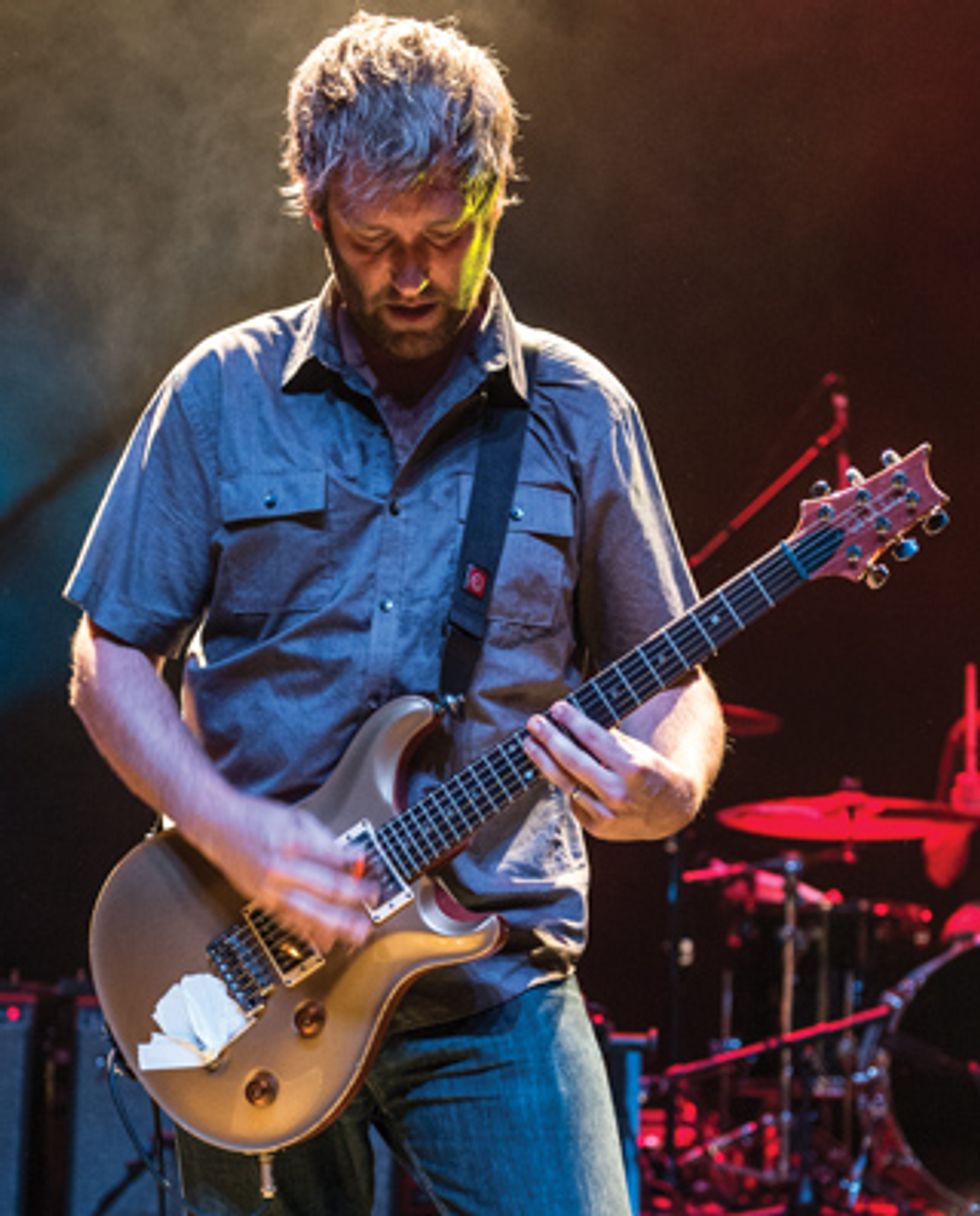 Photo by Elise Shively
Photo by Elise ShivelyThere’s a new Minus the Bear
tab book coming out, right?
Yeah, we were hoping to have
it ready for this fall tour, but it
looks like it won’t be ready until
next year.
Does the book reduce some of
the guitar- and effects-intensive
songs to more straightahead,
strummed arrangements
so fans that aren’t as
proficient on guitar or don’t
have looping equipment can
still play the song in some
capacity?
When we did Acoustics, where
we reworked a lot of songs that
were crazy into acoustic versions,
that whole process was
figuring out, “Okay, how am
I going to play this crazy tapping,
delayed-out, sampled riff
on acoustic guitar?” The new
songbook will be more technical
than strum-along, but we
do deconstruct the songs every
once in a while—and we will be
doing another acoustic record.
How will you explain parts
that can’t be notated, like
loops and the triggering of
samples on your various Line
6 DL4s?
That’s one of the things we’re
figuring out how to notate
[laughs]. “Knights” is the first
song that we’ve been working,
and it requires two DL4s and
a lot of re-triggering. It would
be like, “Play this chord shape,
sample it into the DL4, then
play this chord shape into the
other DL4, sample it, and then
use this rhythm to play the riff.”
How many DL4s do you have
on your pedalboard?
On my live board, I have four
DL4s. One is strictly for delay,
and the other three are for sampling/
delay—when we’re playing
live, sometimes I’ll need to have
a couple of samples ready to go.
Because you can’t save samples
on the DL4, do you have to
record them live at every gig?
Yeah—most of the time it’s
done during the riff of a song.
I have a Boss compressor at the
end of my chain, so if a song
needs to be sampled before the
song starts, I’ll hit that compressor
to lower the volume
super low so that it doesn’t go
out loud. I’ll sample before I
turn the guitar up, and then go
back to full volume.
Do you ever mess up
live samples?
Oh, absolutely! [Laughs.]
There’ll be times when I’ll
be sampling “Knights” in the
middle of a set, and I’ll think
the tempo’s right for one of the
samples and it will be either too
fast or too slow. But, y’know,
that’s just part of the live thing.
I feel that it’s more real and
authentic that way.
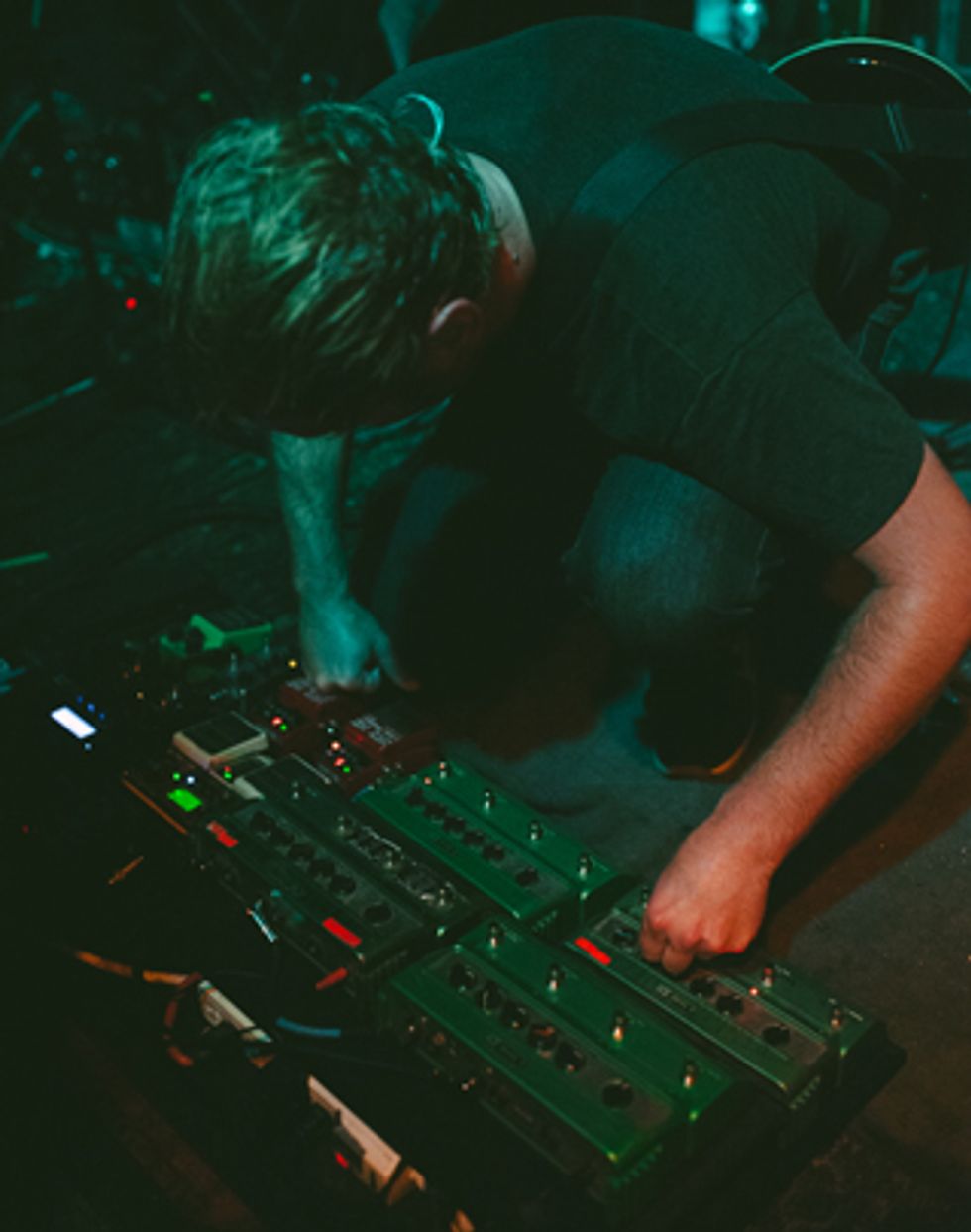
It’s not uncommon for Knudson to hover over and go to town on his Line 6 Delay Modelers. Photo by Amber Zbitnoff
How do you recover when
that happens—do you stop
the sample and try again at an
inconspicuous spot?
If I can redo it and it’s not
going to be, like, “Oh my god,
where did the guitar go?” then
I’ll do it. Otherwise, you just
roll with the punches. There
are other times when the DL4
will just lose power—like, if
you’re playing at a super-hot
club and it’s really sweaty and
there’s condensation everywhere.
Sometimes they just
turn off and it’s, like, “There’s
a big sampling part coming up
and my pedal just turned off—
what’s going to happen?”
Although the DL4 is an iconic
pedal, some units are known
to have reliability issues. In
addition to what you just mentioned,
have you encountered
other issues with your units?
I’ve had a problem where, if I’m
sampling something at soundcheck
and then I leave them on
for a couple of hours so I can
just go out and start playing,
it seems like the volume gets
lower. I don’t do that anymore.
Have you thought about using
a laptop to expand your live
sampling capabilities?
You know, we talked about that
before—Alex is super into that
kind of stuff—but I really do
love just pedals and playing
guitar, and I don’t want to have
to bring a computer with me.
I just like all the classic guitar
stuff, and if I can get my sounds
within that context, great.
Although a laptop-based rig
might be more precise than a
DL4, there’s something cooler
about doing a live sample and
not knowing for sure if it’s
going to be surgically precise.
Exactly. It adds to the coolness
of the show and the urgency of
the performance.
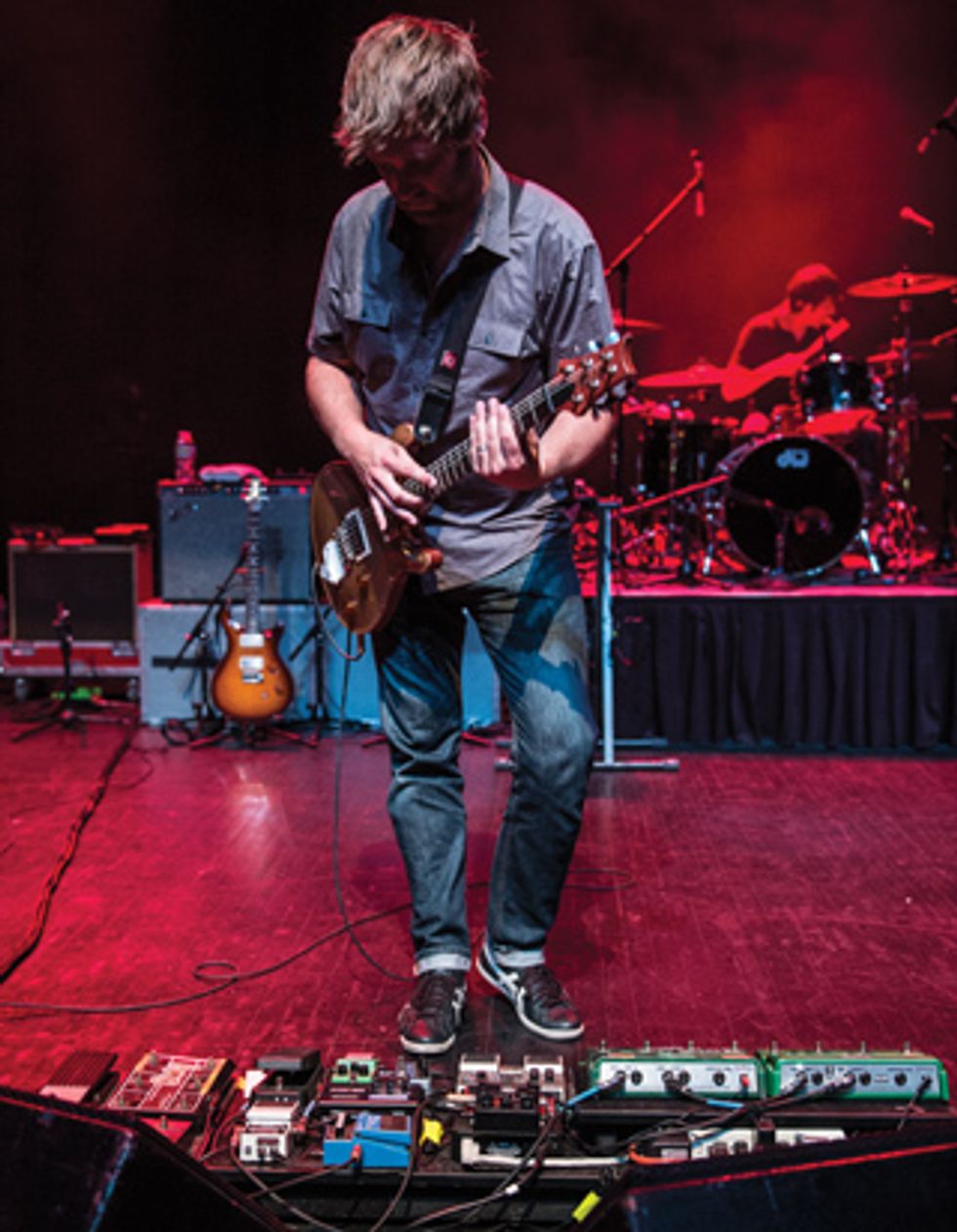
Photo by Elise Shively
What are your guitars of choice?
My main guitar is a goldtop
PRS McCarty that I got about
12 years ago, a little before the
band started. My second favorite
is a PRS Custom 24. Those are
the main guitars I used on the
record. I also used Matt’s ’60s
Epiphone Casino, which is just
a gorgeous-sounding guitar. A
lot of the overdubs were done
with the Casino, and the main
tracks were done with the PRS
guitars.
How about amps?
I love Fender Twins—that’s
my go-to amp. I love the headroom,
the dynamics, and the
brightness. The top end is just
so sparkly and rich. I use a Vox
AC30 every once in a while.
I did some overdubs with an
Orange head, and I used a
Mesa/Boogie Lone Star Classic
for some songs.
Did you use the Lone Star in
100-, 50-, or 10-watt mode?
I think I have it running on 50
watts. What I like to do on my
rig now is play through a Twin
and a Lone Star in stereo, with
a little bit of reverb on the Twin
and the Lone Star totally dry.
What do you use for your
dirty tones?
A Tube Screamer’s been on my
board for probably the past 10
years, but the pedal I love most
is the Z.Vex Box of Rock—I
just love the boost on that. It
makes everything refreshing
and wonderful sounding. Then
I turn the fuzz on and it gets
super nasty.
LEFT: Minus the Bear guitarist Dave Knudson plugs into a Mesa/
Boogie Lone Star Classic (left) and a Fender Twin Reverb. MIDDLE:
His four Line 6 delays take up half of his pedalboard. RIGHT: Knudson
sticks with his PRS goldtop (left) much of the time, or his
PRS Custom 24 models.
How would you contrast the
distortion from a raging stack
versus that of a dirt pedal into
a Twin?
When I was in Botch
[Knudson’s previous hardcore
band], I had a stereo rig that
was a Peavey 5150 4x12 on
one side and a Dual Rectifier
4x12 on the other. I loved that
power and the stereo setup, but
y’know, there’s just something
about the Twin. It has more
vibe—it has more emotion,
depending on how hard you’re
playing and the feel of the song.
So I do prefer my current rig.
Dave Knudson's Gear
Guitars
PRS McCarty goldtop,
PRS Custom 24
Amps
Fender Twin Reverb,
Mesa/Boogie Lone Star Classic
Effects
Four Line 6 DL4 Delay Modelers,
Line 6 M5,
Electro-Harmonix HOG,
Ibanez Tube Screamer,
Z.Vex Box of Rock,
Boss DD–20 Giga Delay,
Strymon BlueSky Reverberator
Strings, Picks, and Accessories
Jim Dunlop .010–.046 sets,
Dunlop Tortex .60 mm picks,
Planet Waves American Stage cables
What other effects do you use?
One of those old-school Roland
tape echoes, but I keep that in
the studio. I also use a Boss
Giga Delay. The Strymon
BlueSky Reverberator is another
pedal that is amazing. It made
it on to a couple of overdubs.
It’s not on all the time—I use
it when I need a more extreme
reverb sound.
How do you guys successfully
meld such creative effects use
and such seemingly incongruous
styles into an accessible
package? Do you consciously
avoid not going too far in one
direction—like, if it gets too
prog-y, it might alienate a segment
of your audience?
[Laughs.] It’s funny, y’know,
we don’t really think about it.
We just kind of write what
comes naturally to us, and what
we think is cool. Planet of Ice
is definitely the most prog-y
record, but it’s also one of our
fans’ all-time favorites. For the
most part, fans have been really
supportive of any direction we
go. That’s been one of the goals
of the band for a long time, to
create complex music that can
be appreciated by more than
just music nerds.
YouTube It
For a taste of Minus the Bear’s indie-prog stylings, check
out the following clips on YouTube.com.
Minus the Bear’s “Lies and Eyes”
presents a firsthand look at Dave
Knudson’s melodic approach to
rhythm guitar.
Line 6 DL4 madness abounds in
this live clip of Minus the Bear’s
“Knights”—especially at the 2:36
mark, where Knudson uses a
two-footed, two-pedal tap-dance
approach to trigger stuttering,
synth-like parts.
Watch MTB’s masterfully sparse
interplay in this slow-build atmospheric
jam. By the 2:50 mark,
Knudson has abandoned his
two-footed, loop-triggering approach
and gotten on his knees
to play two DL4s like a keyboard
while singer Jake Snider weaves
in feedback-riddled mayhem with
his Bigsby-equipped Telecaster.















![Rig Rundown: Russian Circles’ Mike Sullivan [2025]](https://www.premierguitar.com/media-library/youtube.jpg?id=62303631&width=1245&height=700&quality=70&coordinates=0%2C0%2C0%2C0)
















![Rig Rundown: AFI [2025]](https://www.premierguitar.com/media-library/youtube.jpg?id=62064741&width=1245&height=700&quality=70&coordinates=0%2C0%2C0%2C0)




















 Zach loves his Sovtek Mig 60 head, which he plays through a cab he built himself at a pipe-organ shop in Denver. Every glue joint is lined with thin leather for maximum air tightness, and it’s stocked with Celestion G12M Greenback speakers.
Zach loves his Sovtek Mig 60 head, which he plays through a cab he built himself at a pipe-organ shop in Denver. Every glue joint is lined with thin leather for maximum air tightness, and it’s stocked with Celestion G12M Greenback speakers.






